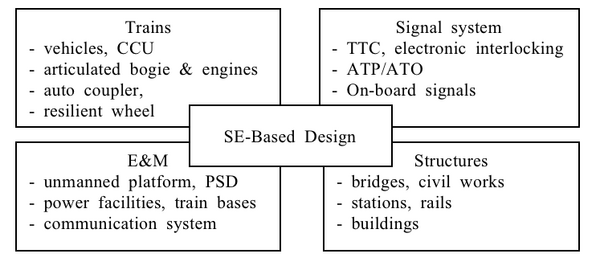Difference between revisions of "Standard Korean Light Transit System"
| Line 9: | Line 9: | ||
The elements of the [[Acronyms|SKLTS]] were classified into four groups (as shown in Figure 1): trains, signal systems, electric and machinery [[Acronyms|(E&M)]] systems, and structures. Trains and vehicles were to be automatically operated, without need for human operators. Operation systems and their interfaces were based on digital signals and communications. For [[Acronyms|SKLTS]], SE-based design activities focused on reliability, availability, maintainability, and safety ([[Acronyms|RAMS]]), and were integrated into project management activities during all phases. | The elements of the [[Acronyms|SKLTS]] were classified into four groups (as shown in Figure 1): trains, signal systems, electric and machinery [[Acronyms|(E&M)]] systems, and structures. Trains and vehicles were to be automatically operated, without need for human operators. Operation systems and their interfaces were based on digital signals and communications. For [[Acronyms|SKLTS]], SE-based design activities focused on reliability, availability, maintainability, and safety ([[Acronyms|RAMS]]), and were integrated into project management activities during all phases. | ||
| − | [[File:ChoeKimFigure1.png|thumb|center|600px|Figure 1. Subsystems of the SKLTS (Ahn, 2005) (Notes: CCU: Central Control Unit; TTC: Total Traffic Control; ATP: Automatic Train Protection; ATO: Automatic Train Operation; PSD: Platform Screen Door) Reprinted with permission of Journal of the Korean Society for Railway.]] | + | [[File:ChoeKimFigure1.png|thumb|center|600px|'''Figure 1. Subsystems of the SKLTS (Ahn, 2005).''' (Notes: CCU: Central Control Unit; TTC: Total Traffic Control; ATP: Automatic Train Protection; ATO: Automatic Train Operation; PSD: Platform Screen Door) Reprinted with permission of Journal of the Korean Society for Railway.]] |
The [[Life Cycle Models|project life cycle]] for the [[Acronyms|SKLTS]] is summarized in Figure 2. It consisted of 7 phases: concept studies, concept development, preliminary design, design, system production and testing, performance evaluation, and operation/maintenance/close-out [[Acronyms|(OMC)]] - please see (Choi 2007) and (Chung et al. 2010) for further details. These phases, with the exception of the production and test phases, are completed through an evaluation and decision point [[Acronyms|(EDP)]] ([[Milestone (glossary)|milestone]]), depicted as a colored circle in Figure 2. These EDPs correspond to common life cycle artifacts such as requests for proposal [[Acronyms|RFPs)]], proposals, preliminary design reviews [[Acronyms| (PDRs)]], and critical design reviews [[Acronyms| (CDRs)]]. | The [[Life Cycle Models|project life cycle]] for the [[Acronyms|SKLTS]] is summarized in Figure 2. It consisted of 7 phases: concept studies, concept development, preliminary design, design, system production and testing, performance evaluation, and operation/maintenance/close-out [[Acronyms|(OMC)]] - please see (Choi 2007) and (Chung et al. 2010) for further details. These phases, with the exception of the production and test phases, are completed through an evaluation and decision point [[Acronyms|(EDP)]] ([[Milestone (glossary)|milestone]]), depicted as a colored circle in Figure 2. These EDPs correspond to common life cycle artifacts such as requests for proposal [[Acronyms|RFPs)]], proposals, preliminary design reviews [[Acronyms| (PDRs)]], and critical design reviews [[Acronyms| (CDRs)]]. | ||
| − | [[File:ChoeKimFigure2.png|thumb|center|600px|Figure 2. 7 phases of the [[Acronyms|SKLTS]] development (Ahn 2005) Reprinted with permission of the Journal of the Korean Society for Railway]] | + | [[File:ChoeKimFigure2.png|thumb|center|600px|'''Figure 2. 7 phases of the [[Acronyms|SKLTS]] development (Ahn 2005).''' Reprinted with permission of the Journal of the Korean Society for Railway]] |
| Line 20: | Line 20: | ||
| − | <center>'''Table 1. The SE framework of the [[Acronyms|SKLTS]] (Ahn 2005) Reprinted with permission of the Journal of the Korean Society for Railway. | + | <center>'''Table 1. The SE framework of the [[Acronyms|SKLTS]] (Ahn 2005).''' Reprinted with permission of the Journal of the Korean Society for Railway.</center> |
[[File:ChoeKimTABLE1.png|thumb|center|600px]] | [[File:ChoeKimTABLE1.png|thumb|center|600px]] | ||
Revision as of 21:27, 17 August 2012
This vignette deals with systems engineering (se) concepts and guidelines applied to the development of the Standard Korean Light Transit System (SKLTS). In Korea, local authorities had historically been interested in light transit to help resolve their transportation problems. The SKLTS was a joint effort between local authorities and the central government. It was built to provide a standard platform on which any local authority could construct its own light transit system. The issues of stakeholder requirements, safety, and reliability, availability, and maintainability were critical to the development of a successful system.
Application domain: transportation, unmanned systems
Application uses: services, enterprises
Vignette Description
The elements of the SKLTS were classified into four groups (as shown in Figure 1): trains, signal systems, electric and machinery (E&M) systems, and structures. Trains and vehicles were to be automatically operated, without need for human operators. Operation systems and their interfaces were based on digital signals and communications. For SKLTS, SE-based design activities focused on reliability, availability, maintainability, and safety (RAMS), and were integrated into project management activities during all phases.
The project life cycle for the SKLTS is summarized in Figure 2. It consisted of 7 phases: concept studies, concept development, preliminary design, design, system production and testing, performance evaluation, and operation/maintenance/close-out (OMC) - please see (Choi 2007) and (Chung et al. 2010) for further details. These phases, with the exception of the production and test phases, are completed through an evaluation and decision point (EDP) (milestone), depicted as a colored circle in Figure 2. These EDPs correspond to common life cycle artifacts such as requests for proposal RFPs), proposals, preliminary design reviews (PDRs), and critical design reviews (CDRs).

During the SKLTS development, SE activities were focused on RAMS as summarized in Table 1.
In the "concept studies" and "concept development" phases, requirements included the RAMS objectives. Planning activities in this phase included the scheduling of various tests and evaluations to be conducted after system design. The basic layout of rails and command rooms was also proposed. Finally, it was during this phase that interface management procedures and relationships between requirements and systems were defined. For RAMS engineering, it was also important to establish associated plans and criteria (e.g., RAM plans, safety plans, service availability, etc.).
During the pre-design phase, the basic architecture of the system was determined for safety planning, RAMS planning, and operational scenarios. Interfaces among subsystems were defined as well as management procedures for contractors and legal regulations. The functional analysis dealt with timeline, accuracy of stop points, and trip times. Pre-design activities also included the specifications of major system elements such as signal systems, trains, and interfaces. For RAMS engineering, safety scenarios were defined, and the hazard and risk analyses were performed.
During the design and performance evaluation phases, hazard log and RAMS analyses were performed to ensure that each subsystem met safety requirements. The specifications of alarm systems and stations were also defined. In addition, (V&V) and test procedures were determined for performance evaluation. During the design phase, a design/construction interface manual (D/CIM) was developed and applied to ensure integrated and consistent design. (Bombardier, 2005)
Because SKLTS was designed as an automatically-driven system, RAMS issues were critical to its success. The safety and reliability of the SKLTS were evaluated on a test railway that was constructed to standard specifications. Data was gathered from existing Korean light rail systems, as well as the light rail systems from other countries, to support verification and validation activities.
Various methods were applied for achieving the RAMS objectives, including RAMS requirements analysis, safety and RAMS planning, utilization of systems scenarios, and construction risk analysis.
Initial operation of SKLTS was allowed only after the system was formally accepted and operators were properly certified. During test operation, RAMS performance was continuously monitored and system scenarios were used successfully to evaluate the dynamic behavior of the system. A failure reporting and corrective action system (FRACAS) was used to gather accident and failure data. Continuous improvement when the system is in normal operation was identified as a requirement; the results from the FRACAS will be used to support improvement of the system, maintenance, and improvement of procedures.
Summary
Korean local authorities have successfully introduced the SKLTS to their precincts with some modifications. Successful examples include the Inchun Airport Line and the Seoul 9th Subway Line. One lesson learned identified was that requirement analysis, especially in the first few phases, should have been more complete.
References
Works Cited
Ahn, S.H. 2005. “Systems Engineering Applied to the Construction of Unmanned Light Rail Transit Systems.” Journal of the Korean Society for Railway. 8(2): 41-49.
Bombardier. 2005. Design/Construction Interface Manual. Montréal, Québec, Canada: Bombardier.
Choi, Y.C. 2007. "Systems Engineering Application Model for the National R&D Project: Focusing on the Railway Systems." Ph.D. dissertation, Ajou University, 2007.
Chung, S. Y., S.G. Lee, D.W. Lee, and S.T. Jeon. 2010. “A Study on The Application Model of Systems Engineering to Advance the Business of the Light Rail Transit (LRT).” Proceedings on the Autumn Conference of the Korean Society for Railway, p. 24-30.
Primary References
No primary references have been identified for version 1.0.
Additional References
Han, S.Y. and A.H. Lee. 2005. System Engineering for The Technology Development Program of Light Transit Systems: Internal Research Report. Gyeongi-do, Korea: Korea Railroad Research Institute.
Korean Agency for Technology and Standards. 2009. KSX ISO/IEC 15288: Life Cycle Processes of IT Systems Based on Systems and Software Engineering, Research Report. Gyeonggi-do, Korea: Korean Agency for Technology and Standards.
Lee, W.D. 2002. “A Study on the Top-Level Functional Analysis for the Automated Guideway Transit by System Engineering Tools.” Proceedings of the Autumn Conference of the Korean Society for Railway, p. 202-207.
Comments from SEBok 0.5 Wiki
No comments were logged for this article in the SEBoK 0.5 wiki. Because of this, it is especially important for reviewers to provide feedback on this article. Please see the discussion prompts below.
SEBoK Discussion
Please provide your comments and feedback on the SEBoK below. You will need to log in to DISQUS using an existing account (e.g. Yahoo, Google, Facebook, Twitter, etc.) or create a DISQUS account. Simply type your comment in the text field below and DISQUS will guide you through the login or registration steps. Feedback will be archived and used for future updates to the SEBoK. If you provided a comment that is no longer listed, that comment has been adjudicated. You can view adjudication for comments submitted prior to SEBoK v. 1.0 at SEBoK Review and Adjudication. Later comments are addressed and changes are summarized in the Letter from the Editor and Acknowledgements and Release History.
If you would like to provide edits on this article, recommend new content, or make comments on the SEBoK as a whole, please see the SEBoK Sandbox.
blog comments powered by Disqus
